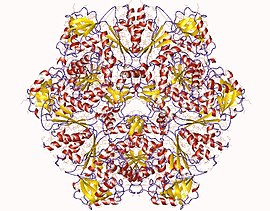|
Adenylyl-sulfate kinase
In enzymology, an adenylyl-sulfate kinase (EC 2.7.1.25) is an enzyme that catalyzes the chemical reaction
Thus, the two substrates of this enzyme are ATP and adenylyl sulfate, whereas its two products are ADP and 3'-phosphoadenylyl sulfate. This enzyme belongs to the family of transferases, specifically those transferring phosphorus-containing groups (phosphotransferases) with an alcohol group as acceptor. The systematic name of this enzyme class is ATP:adenylyl-sulfate 3'-phosphotransferase. Other names in common use include adenylylsulfate kinase (phosphorylating), 5'-phosphoadenosine sulfate kinase, adenosine 5'-phosphosulfate kinase, adenosine phosphosulfate kinase, adenosine phosphosulfokinase, adenosine-5'-phosphosulfate-3'-phosphokinase, and APS kinase. This enzyme participates in 3 metabolic pathways: purine metabolism, selenoamino acid metabolism, and sulfur metabolism. This enzyme contains an ATP binding P-loop motif.[1] Structural studiesAs of late 2007, 11 structures have been solved for this class of enzymes, with PDB accession codes 1D6J, 1M7G, 1M7H, 1X6V, 1XJQ, 1XNJ, 2AX4, 2GKS, 2OFW, 2OFX, and 2PEY. References
Further reading
|
||||||||||||||||||||||||||||||||||||||||||||||||||||||||||||||||||


